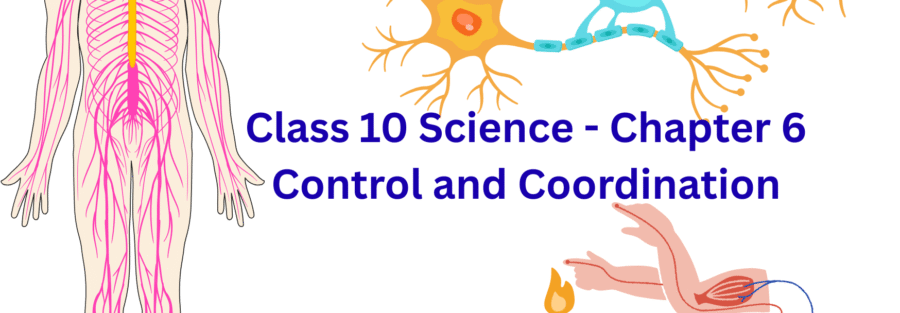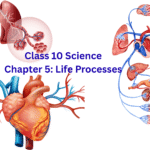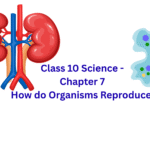Control and Coordination – Short Notes
1. Introduction
- Organisms must respond to changes in their environment (stimuli) for survival.
- Control: The power to regulate various functions.
- Coordination: The harmonious working of different organs together.
2. Animals – Nervous System
Uses electrical impulses for fast, short-lived responses.
A. Neuron (Nerve Cell): Structural & functional unit.
- Parts:
- Dendrite: Receives information.
- Cell Body: Contains nucleus.
- Axon: Conducts impulse away from cell body.
- Synapse: Junction between two neurons where neurotransmitters chemically transmit the impulse.
B. Reflex Action:
- A quick, automatic, involuntary response to a stimulus.
- The path taken is a Reflex Arc.
- Path: Receptor → Sensory Neuron → Spinal Cord (Relay Neuron) → Motor Neuron → Effector (Muscle/Gland)
- Example: Quickly pulling your hand away from a hot object.
C. Human Brain:
Protected by the skull and has three main parts:
| Part of Brain | Function |
|---|---|
| Fore-brain (Cerebrum) | – Controls voluntary actions. – Center for reasoning, learning, intelligence, memory, language. |
| Mid-brain | – Controls reflex movements of head, neck, and eyes. |
| Hind-brain (Cerebellum + Medulla) | Cerebellum: Controls body posture, balance, and coordination. Medulla oblongata: Controls involuntary actions (e.g., blood pressure, vomiting, salivation, heartbeat). |
3. Coordination in Plants
Plants use chemicals (hormones) for control and coordination. They respond to stimuli by directional growth called Tropisms.
A. Types of Tropisms:
- Phototropism: Growth in response to light (e.g., shoots grow towards light → positive).
- Geotropism: Growth in response to gravity (e.g., roots grow downwards → positive).
- Hydrotropism: Growth in response to water.
- Chemotropism: Growth in response to chemicals (e.g., pollen tube growing towards an ovule).
B. Plant Hormones (Phytohormones):
| Hormone | Function |
|---|---|
| Auxin | – Cell elongation – Phototropism |
| Gibberellin | – Stem elongation – Seed germination |
| Cytokinin | – Promotes cell division – Delays ageing (senescence) |
| Abscisic Acid (ABA) | – Inhibits growth – Promotes wilting (abscission) – Causes dormancy in seeds & buds |
| Ethylene | – Promotes fruit ripening – Promotes ageing |
4. Animals – Endocrine System
Uses chemical messengers (hormones) secreted by endocrine glands for slower, long-lasting responses.
Important Glands & Hormones:
| Endocrine Gland | Hormone Secreted | Function |
|---|---|---|
| Pituitary Gland | Growth Hormone | Regulates growth and development. |
| Thyroid | Thyroxine | Regulates metabolism (carbohydrate, protein, fat). |
| Pancreas | Insulin | Lowers blood sugar level. |
| Adrenal Gland | Adrenaline | “Fight or Flight” hormone. Prepares body for emergency (increases heart rate, breathing, blood pressure). |
| Testes (Male) | Testosterone | Controls male secondary sexual characters. |
| Ovaries (Female) | Estrogen | Controls female secondary sexual characters. |
- Feedback Mechanism: Regulates hormone secretion. Example: When blood sugar rises, insulin is secreted; when it lowers, secretion stops.
5. Comparison: Nervous vs. Hormonal Control
| Aspect | Nervous Control | Hormonal Control |
|---|---|---|
| Nature | Electrical impulses | Chemical hormones |
| Speed | Very rapid | Slower |
| Duration | Short-lived | Long-lasting |
| Effect | Localized | Widespread |
Quick Revision: Key Terms
- Stimulus: A change in the environment that an organism responds to.
- Response: The reaction of an organism to a stimulus.
- Receptors: Specialized structures that detect stimuli (e.g., taste buds, photoreceptors in eyes).
- Effectors: Organs (muscles or glands) that show the response.
Important Diagrams to Practice
- Structure of a Neuron
- Reflex Arc
- Human Brain
- Endocrine Glands in Human Body
Exam Tip: This chapter is crucial for 3-5 mark questions. Focus on definitions, examples, differences, and labeled diagrams.
कक्षा 10 विज्ञान – अध्याय 7: नियंत्रण एवं समन्वय – संक्षिप्त नोट्स
1. परिचय
- जीवों को अपने पर्यावरण में परिवर्तन (उद्दीपन) का उत्तर देने की आवश्यकता होती है।
- नियंत्रण: विभिन्न कार्यों को विनियमित करने की शक्ति।
- समन्वय: विभिन्न अंगों का सामंजस्यपूर्ण कार्य।
2. जंतु – तंत्रिका तंत्र
तेज, अल्पकालिक प्रतिक्रियाओं के लिए विद्युत आवेगों का उपयोग करता है।
A. तंत्रिका कोशिका (न्यूरॉन): संरचनात्मक एवं कार्यात्मक इकाई।
- भाग:
- द्रुमिका (Dendrite): सूचना प्राप्त करती है।
- कोशिका काय (Cell Body): केंद्रक होता है।
- अक्षतंतु (Axon): कोशिका काय से दूर आवेग का संचालन करता है।
- सिनेप्स: दो न्यूरॉन्स के बीच का जंक्शन जहाँ न्यूरोट्रांसमीटर रासायनिक रूप से आवेग संचारित करते हैं।
B. प्रतिवर्ती क्रिया (Reflex Action):
- उद्दीपन के प्रति एक त्वरित, स्वचालित, अनैच्छिक प्रतिक्रिया।
- जो पथ अपनाया जाता है वह प्रतिवर्ती चाप (Reflex Arc) है।
- पथ: ग्राही → संवेदी न्यूरॉन → मेरुरज्जु (रिले न्यूरॉन) → चालक न्यूरॉन → प्रभावक (मांसपेशी/ग्रंथि)
- उदाहरण: गर्म वस्तु से तुरंत हाथ हटा लेना।
C. मानव मस्तिष्क:
खोपड़ी द्वारा संरक्षित और इसके तीन मुख्य भाग होते हैं:
| मस्तिष्क का भाग | कार्य |
|---|---|
| अग्रमस्तिष्क (प्रमस्तिष्क) | – ऐच्छिक क्रियाओं पर नियंत्रण। – तर्क, अधिगम, बुद्धिमत्ता, स्मृति, भाषा का केंद्र। |
| मध्यमस्तिष्क | – सिर, गर्दन एवं आँखों की प्रतिवर्ती गतियों का नियंत्रण। |
| पश्चमस्तिष्क (अनुमस्तिष्क + मेडुला) | अनुमस्तिष्क: शरीर की मुद्रा, संतुलन और समन्वय नियंत्रित करता है। मेडुला ऑब्लोंगेटा: अनैच्छिक क्रियाएँ नियंत्रित करता है (जैसे रक्तचाप, उल्टी, लार आना, हृदय स्पंदन)। |
3. पादपों में समन्वय
पादप रसायन (हार्मोन) का उपयोग करते हैं। वे प्रेरण (Tropisms) नामक दिशात्मक वृद्धि द्वारा उद्दीपनों का उत्तर देते हैं।
A. प्रेरण (Tropisms) के प्रकार:
- प्रकाशानुवर्तन (Phototropism): प्रकाश के प्रति वृद्धि (जैसे, प्ररोह प्रकाश की ओर → धनात्मक)।
- गुरुत्वानुवर्तन (Geotropism): गुरुत्वाकर्षण के प्रति वृद्धि (जैसे, जड़ें नीचे की ओर → धनात्मक)।
- जलानुवर्तन (Hydrotropism): जल के प्रति वृद्धि।
- रसायनानुवर्तन (Chemotropism): रसायनों के प्रति वृद्धि (जैसे, परागनली का बीजांड की ओर बढ़ना)।
B. पादप हार्मोन (फाइटोहार्मोन):
| हार्मोन | कार्य |
|---|---|
| ऑक्सिन | – कोशिका दीर्घीकरण – प्रकाशानुवर्तन |
| जिब्बेरेलिन | – तना दीर्घीकरण – बीज अंकुरण |
| साइटोकाइनिन | – कोशिका विभाजन को बढ़ावा – वृद्धि को विलंबित करता है (वार्धक्य) |
| एब्सिसिक अम्ल (ABA) | – वृद्धि को रोकता है – पर्णपात को बढ़ावा – बीजों एवं कलिकाओं में प्रसुप्ति उत्पन्न करता है |
| एथिलीन | – फल पकाने को बढ़ावा – वृद्धि को बढ़ावा |
4. जंतु – अंत:स्रावी तंत्र
धीमी, दीर्घकालिक प्रतिक्रियाओं के लिए अंत:स्रावी ग्रंथियों द्वारा स्रावित रासायनिक दूत (हार्मोन) का उपयोग करता है।
महत्वपूर्ण ग्रंथियाँ एवं हार्मोन:
| अंत:स्रावी ग्रंथि | स्रावित हार्मोन | कार्य |
|---|---|---|
| पीयूष ग्रंथि | वृद्धि हार्मोन | वृद्धि और विकास को नियंत्रित करता है। |
| अवटुग्रंथि (Thyroid) | थाइरॉक्सिन | चयापचय (कार्बोहाइड्रेट, प्रोटीन, वसा) को नियंत्रित करता है। |
| अग्न्याशय (Pancreas) | इंसुलिन | रक्त शर्करा का स्तर कम करता है। |
| अधिवृक्क ग्रंथि | एड्रीनलीन | “लड़ो या भागो” हार्मोन। आपात स्थिति के लिए शरीर को तैयार करता है (हृदय गति, श्वास, रक्तचाप बढ़ाता है)। |
| वृषण (नर) | टेस्टोस्टेरोन | नर द्वितीयक यौन लक्षणों को नियंत्रित करता है। |
| अंडाशय (मादा) | एस्ट्रोजन | मादा द्वितीयक यौन लक्षणों को नियंत्रित करता है। |
- प्रतिपुष्टि तंत्र (Feedback Mechanism): हार्मोन स्राव को नियंत्रित करता है। उदाहरण: रक्त शर्करा बढ़ने पर इंसुलिन स्रावित होता है; कम होने पर स्राव रुक जाता है।
5. तुलना: तंत्रिकीय vs. हार्मोनल नियंत्रण
| पहलू | तंत्रिकीय नियंत्रण | हार्मोनल नियंत्रण |
|---|---|---|
| प्रकृति | विद्युत आवेग | रासायनिक हार्मोन |
| गति | अत्यंत तीव्र | धीमी |
| अवधि | अल्पकालिक | दीर्घकालिक |
| प्रभाव | स्थानीयकृत | व्यापक |
त्वरित संशोधन: मुख्य शब्द
- उद्दीपन (Stimulus): पर्यावरण में परिवर्तन जिसका जीव उत्तर देता है।
- अनुक्रिया (Response): उद्दीपन के प्रति जीव की प्रतिक्रिया।
- ग्राही (Receptors): विशेषित संरचनाएँ जो उद्दीपनों का पता लगाती हैं (जैसे स्वाद कलिकाएँ, आँखों में प्रकाशग्राही)।
- प्रभावक (Effectors): अंग (मांसपेशियाँ या ग्रंथियाँ) जो अनुक्रिया प्रदर्शित करते हैं।
अभ्यास के लिए महत्वपूर्ण आरेख
- न्यूरॉन की संरचना
- प्रतिवर्ती चाप
- मानव मस्तिष्क
- मानव शरीर में अंत:स्रावी ग्रंथियाँ
परीक्षा सुझाव: यह अध्याय 3-5 अंकों के प्रश्नों के लिए महत्वपूर्ण है। परिभाषाओं, उदाहरणों, अंतरों और नामांकित आरेखों पर ध्यान दें।



